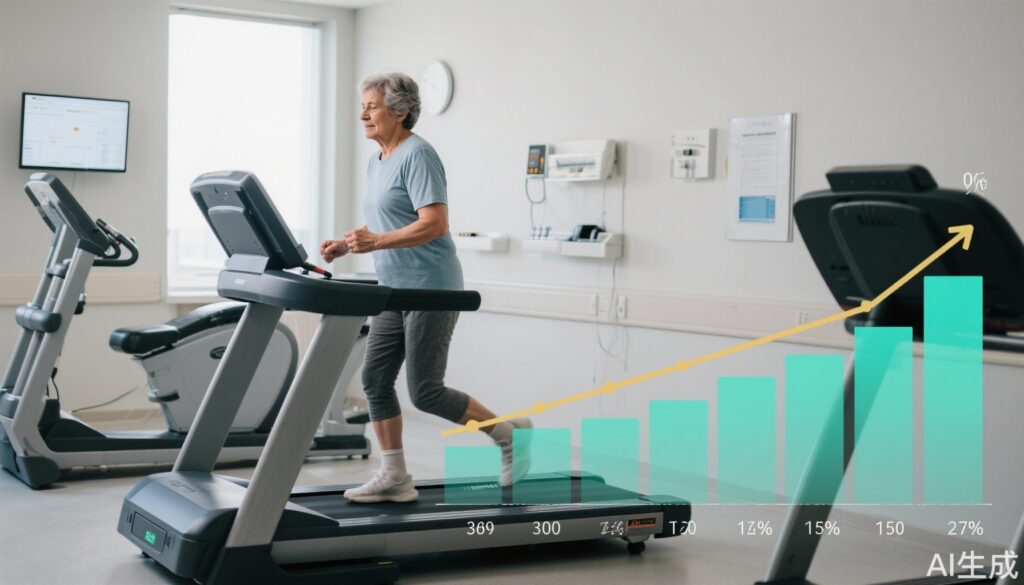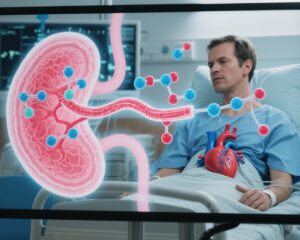Highlight
- Supervised treadmill exercise in peripheral artery disease (PAD) leads to significant walking distance improvements detectable after more than 6 weeks of intervention.
- By 12 weeks, patients achieve large clinically meaningful gains in 6-minute walk distance and self-reported walking ability.
- Improvements in patient-reported walking ability peak at 12 weeks but are not sustained at 26 weeks despite ongoing exercise.
- These findings provide important insights for optimizing duration and expectations of exercise rehabilitation programs in PAD management.
Study Background and Disease Burden
Peripheral artery disease (PAD) affects millions worldwide, characterized by atherosclerotic obstruction of lower extremity arteries. This condition leads to leg ischemia during exertion, causing claudication, functional impairment, and reduced quality of life. Walking limitation is one of the most disabling symptoms and a strong predictor of morbidity and mortality in PAD patients. Supervised treadmill exercise is a cornerstone of noninvasive therapy, proven to improve walking distance and functional capacity in this population. However, the timeline over which these benefits emerge and attain clinical significance is less well defined, hampering optimal program design and patient counseling. Understanding the minimum effective duration of supervised exercise needed to achieve meaningful clinical improvement can enhance resource allocation and adherence strategies. The study by McDermott et al. addresses this gap by rigorously evaluating the time course of improvement in objective and patient-reported walking outcomes over a 6-month intervention period.
Study Design
This randomized controlled trial enrolled 210 participants aged approximately 67 years with confirmed lower extremity PAD. The cohort had substantial representation of women (39%) and Black individuals (66%), enhancing generalizability. Participants were randomized to either supervised treadmill exercise thrice weekly or a non-exercise control group for 6 months. Primary endpoints were the 6-minute walk distance, with a large clinically important difference (CID) of 20 meters, and the Walking Impairment Questionnaire (WIQ) distance score (range 0–100, with 5 points representing CID). Outcomes were assessed at 6, 12, and 26 weeks using mixed-effects models appropriate for repeated measures.
Key Findings
The trial observed excellent follow-up completion with 95% participants attending at least one follow-up visit. Compared to controls, supervised exercise demonstrated:
– A 13.0 meter improvement in 6-minute walk distance at 6 weeks (P=0.049), which did not reach the pre-defined large CID of 20 meters.
– By 12 weeks, a significant and large clinically meaningful improvement of 31.8 meters (P<0.001) was achieved, sustained through 26 weeks (33.9 meters; P<0.001).
Similarly, self-reported walking ability via the WIQ distance score showed:
– No significant improvement at 6 weeks (+2.63 points; P=0.37).
– A statistically significant and clinically meaningful improvement at 12 weeks (+6.59 points; P=0.049).
– By 26 weeks, the WIQ score improvements had diminished and were no longer statistically significant (+2.37 points; P=0.49).
These results highlight a delayed but meaningful response to supervised exercise, with patient perception of walking ability improving later and inconsistent maintenance over time despite continued intervention.
Expert Commentary
This study reinforces the necessity of sustained engagement in structured exercise to derive maximum benefit in PAD. Clinicians should inform patients that meaningful improvements in walking function typically require at least 6 to 12 weeks of supervised treadmill exercise commitment. The attenuation of patient-reported outcomes at 26 weeks may reflect adaptation, motivational factors, or measurement variability, suggesting that complementary behavioral or psychological support might be needed to maintain long-term perception of benefit. Additionally, while objective walking distance gains persist, integrating multifaceted rehabilitation approaches addressing other contributors to PAD-related disability may better sustain comprehensive functional gains.
Limitations include lack of blinding, potential influence of non-exercise lifestyle factors, and absence of detailed mechanistic investigations (e.g., muscle oxygenation or vascular remodeling). Nonetheless, the robust randomized design and diverse cohort strengthen confidence in applicability.
Conclusion
Supervised treadmill exercise for PAD requires more than 6 weeks to achieve substantial clinically important improvements in walking capacity, with maximal patient-perceived benefits emerging around 12 weeks. These findings help set realistic timelines and reinforce the importance of adherence to exercise programs. Future research should explore strategies to sustain patient-reported benefits beyond 6 months and optimize multi-domain interventions to improve long-term outcomes in this high-risk population.
References
1. McDermott MM, Zhang D, Zhao L, Polonsky T, Ferrucci L, Ho KJ, Kibbe MR, Guralnik JM, Criqui MH, Tian L. Duration of Supervised Exercise Necessary for Meaningful Improvement in Peripheral Artery Disease. J Am Heart Assoc. 2025 Sep 5:e040058. doi: 10.1161/JAHA.124.040058.
2. Stewart KJ, Hiatt WR, Regensteiner JG, Hirsch AT. Exercise training for claudication. N Engl J Med. 2002 Mar 28;346(8):699-706.
3. Gardner AW, Montgomery PS. Role of exercise rehabilitation in peripheral artery disease. Curr Treat Options Cardiovasc Med. 2011 Apr;13(2):116-21.
4. Fokkenrood HJ, Bendermacher BL, Lauret GJ, Willigendael EM, Teijink JA. Supervised exercise therapy versus non-supervised exercise therapy for intermittent claudication. Cochrane Database Syst Rev. 2013 Aug 30;(8):CD005263.



